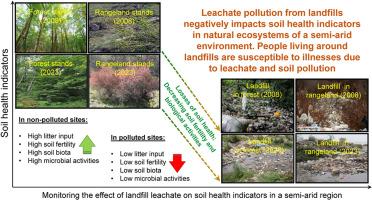垃圾填埋场渗滤液的长期污染抑制了半干旱环境中自然生态系统的土壤健康指标。
IF 8.1
2区 环境科学与生态学
Q1 ENVIRONMENTAL SCIENCES
引用次数: 0
摘要
垃圾填埋对土壤功能和健康构成全球性问题,尤其是在资源有限、无法采用全面废物管理政策(如废物处理和分类技术)的不发达国家。垃圾填埋场的沥滤液排放令人担忧,这主要是因为如果不加以控制,沥滤液在环境中会产生毒害作用,而且垃圾储存地在关闭后可能会产生数百年的沥滤液。世界各国,尤其是发展中国家,在改善垃圾收集和处理设施方面所做的努力很少。本研究旨在调查垃圾渗滤液对伊朗北部半干旱山区天然林地和牧场生态系统土壤健康指标的影响。结果表明,未受污染的森林地点(2008 年)的枯落物和根部营养元素含量最高。垃圾填埋导致土壤容重增加,同时降低了土壤有机质(SOM)、孔隙度、团聚稳定性、颗粒有机碳和氮(POC 和 PON)以及可用养分、铵(NH4+)和硝酸盐(NO3-)的含量。此外,在 2008 年至 2023 年期间,受垃圾填埋场影响的地区的微生物参数(呼吸作用和生物量)和酶类(脲酶、酸性磷酸酶、芳基硫酸酯酶和转化酶)均有所下降。森林和牧场垃圾填埋场(2023 年)三个蚯蚓群的密度和生物量都较低。在垃圾填埋场,蛔虫、疣螈、线虫、原生动物、真菌和细菌的数量也有所减少(几乎是未受污染的森林和牧场的 1-2 倍)。Lumbricus terrestris蚯蚓在所有研究地点都有明显的存在,这表明该蚯蚓物种在严重污染条件下也有活动能力。土壤镉和铅变化的空间模式表明,在研究地点的垃圾填埋场影响下,这些特征的差异很大。最后,土壤健康指标(根据土壤物理、化学和生物参数)从 2008 年的森林未污染地下降到 2023 年的牧场垃圾填埋地,这与垃圾填埋场渗滤液的释放有关。这些结果值得所有依靠自然生态系统进行废物管理而不进行工程操作或技术干预的国家和政府注意。此外,政府和利益相关方都必须实施有效的废物管理系统。这项研究提供了宝贵的信息,可以帮助伊朗和类似地区从事可持续固体废物管理的决策者。此外,强烈建议优先考虑回收利用和植物修复过程。最终,全球为实现环境可持续性所做的努力需要重点关注危险废物的有效管理。因此,应继续对这一主题进行调查,因为通过调查可以评估污染在不受控制的城市固体废物填埋场周围土壤中逐渐积累对环境的影响。本文章由计算机程序翻译,如有差异,请以英文原文为准。

Long-term landfill leachate pollution suppresses soil health indicators in natural ecosystems of a semi-arid environment
Landfills pose a global issue for soil functionality and health, especially in underdeveloped nations where limited resources impede the adoption of comprehensive waste management policies, such as waste processing and sorting techniques. Leachate emissions from waste landfills are a cause for concern, primarily due to their toxic effect if left uncontrolled in the environment, and the potential for waste storage sites to produce leachate for hundreds of years after closure. Few efforts have been made to improve waste collection and disposal facilities in the world, especially in developing countries. This research aims to investigate the influence of waste leachate on soil health indicators in natural woodland and rangeland ecological systems in a semi-arid mountainous region in the north of Iran. Based on results, forest unpolluted sites (2008) exhibited the highest values of nutrient elements in litter and root components. Landfills led to a rise in soil bulk density and a simultaneous decrease in soil organic matter (SOM), porosity, aggregate stability, particulate organic carbon and nitrogen (POC and PON), as well as available nutrients, ammonium (NH4+) and nitrate (NO3−) levels. Additionally, microbial parameters (respiration and biomass) and enzymes (urease, acid phosphatase, arylsulfatase and invertase) experienced a decrease in areas affected by the landfill sites over time of 2008–2023. Forest and rangeland landfill sites (2023) sites had lower density and biomass of the three earthworm groups. Acari, Collembola, nematodes, protozoans, fungi and bacteria were also reduced in landfill sites (nearly 1–2 times more in uncontaminated forest and rangeland sites). Lumbricus terrestris earthworms exhibited a clear presence in all the studied sites, and this demonstrates the ability of this earthworm species to be active in severe pollution conditions. The spatial pattern of soil cadmium and lead changes indicates the high variance of these characteristics under the influence of landfills in the study sites. Finally, the soil health indicators (according to soil physical, chemical, and biological parameters) decreased from forest unpolluted sites in 2008 to rangeland landfill sites in 2023, which is linked to the release of landfill leachate. These results are noteworthy for all countries and governments that rely on natural ecosystems for waste management without engineering operations or technical intervention. Furthermore, both governments and stakeholders must implement effective waste management systems. The research offers valuable information that can assist decision-makers engaged in sustainable solid waste management in Iran and comparable areas. Besides that, it is highly recommended to prioritize recycling and phytoremediation processes. Ultimately, worldwide efforts to achieve environmental sustainability need a significant focus on the effective management of hazardous waste. Consequently, investigations covering this topic should be continued, as they allow the evaluation of the environmental effects of the gradual accumulation of pollution in soils surrounding uncontrolled municipal solid waste landfills.
求助全文
通过发布文献求助,成功后即可免费获取论文全文。
去求助
来源期刊

Chemosphere
环境科学-环境科学
CiteScore
15.80
自引率
8.00%
发文量
4975
审稿时长
3.4 months
期刊介绍:
Chemosphere, being an international multidisciplinary journal, is dedicated to publishing original communications and review articles on chemicals in the environment. The scope covers a wide range of topics, including the identification, quantification, behavior, fate, toxicology, treatment, and remediation of chemicals in the bio-, hydro-, litho-, and atmosphere, ensuring the broad dissemination of research in this field.
 求助内容:
求助内容: 应助结果提醒方式:
应助结果提醒方式:


